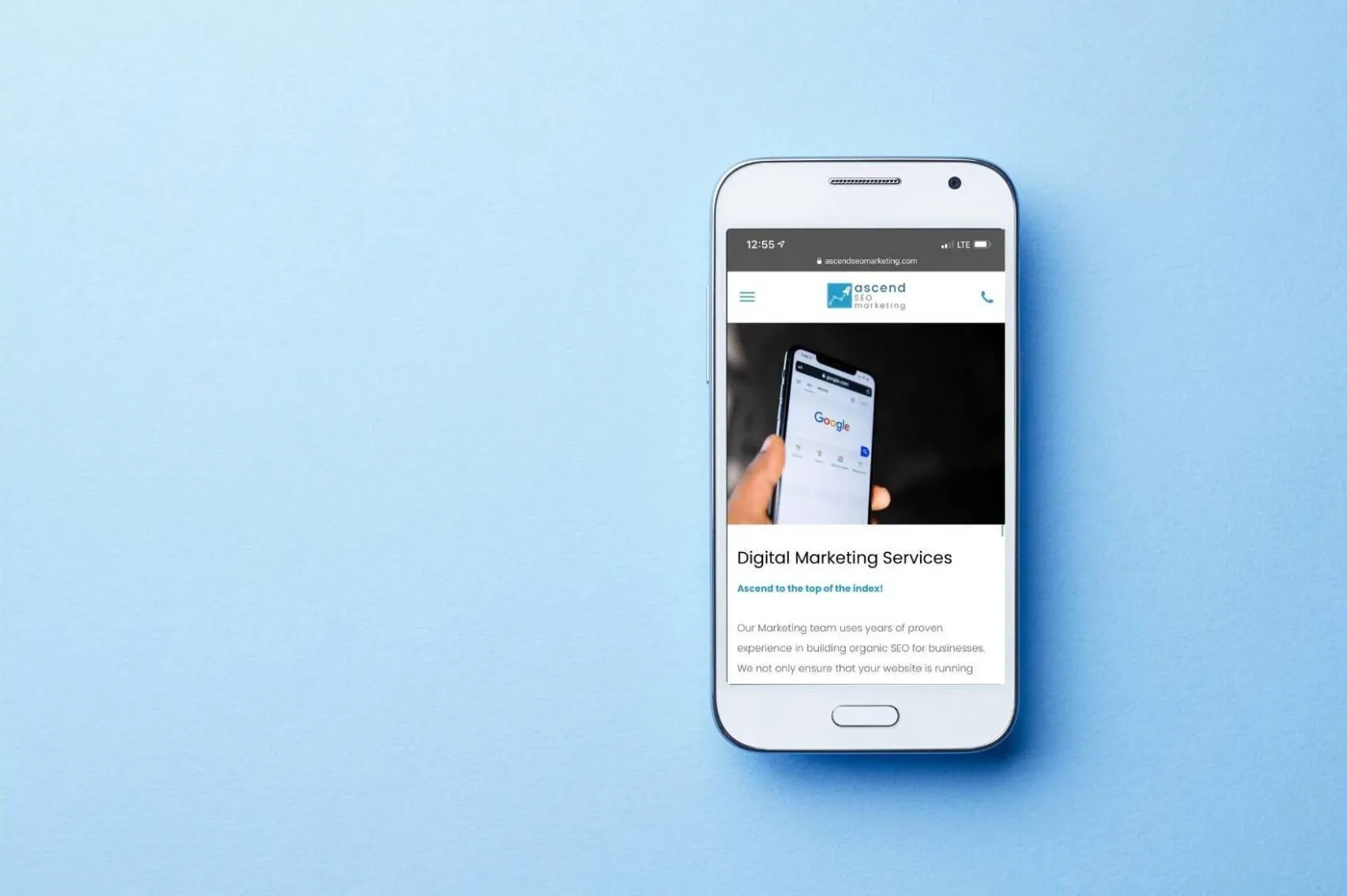Mobile-First Indexing and Small Business Marketing
For a long time, Google has been focusing on mobile-first indexing (which was attributed mainly to a significant shift in how people are searching and browsing the web) and the widespread popularity of mobile in almost every aspect of our lives.
Google has made an effort in recent years to deliver more relevant search results for mobile searches and emphasize results based on which sites function well on mobile devices.
Google will go completely mobile-first in the following months, so be sure you know what that implies and how to prepare. In this article, we’ll go over everything you need to know about mobile-first indexing, including what it is, how it can impact your small business, and ways you can optimize for it.
What Is Google’s Mobile-First Algorithm?
Mobile is here to stay, with a whopping 63% of all US search traffic coming from mobile devices in 2019. This indicates that the mobile version should be prioritized, and Google recognizes this through mobile-first indexing.
Googlebot previously relied on a website’s desktop version to judge a page’s relevancy to a keyword search. Mobile-first algorithm indicates that, in the future, Google will primarily index and rank the mobile version of your site’s content.
What Are the Effects on Digital Marketing for Small Businesses?
Mobile-first indexing won’t be an issue for many organizations because the mobile site is simply a mobile-responsive version of the desktop site with no modifications to the content. However, there are some things to consider if a website has separate mobile and desktop versions.
If you’re one of the few companies that still doesn’t have a mobile-responsive website, you should expect a drop in your search ranks on both mobile and desktop searches. Even if you don’t believe it’s a big deal, it’s still a good idea to know what mobile-first indexing is and the factors you’ll need to consider not just now, but also in the future.

What Impact Does Mobile-First Indexing Have on SEO?
We touched on this briefly in our general explanation of mobile-first indexing, but let’s revisit how it influences SEO and SERP ranks.
The purpose of implementing the mobile-first algorithm was to assess a site’s relevance, rankings, and other characteristics from the same viewpoint as most visitors.
Because the majority of users browse on mobile, Google developed an AI crawl bot that evaluates a site from a mobile viewpoint. As a result, Google will assess your SERP ranking based on the content, performance, and overall optimization detected by the mobile crawl bot.
Hidden or collapsed content provides a significant discrepancy based on technical SEO rules. Hidden content on mobile devices will be regarded the same way as fully visible content, contrary to the desktop version. This is because of the need for efficient screen management, which includes everything “behind” the boxes, such as expandable menus, drop-down lists, and so on.
What Should You Do to Prepare for Mobile-First Indexing?
Now that we understand how much the ongoing Google Mobile-First Algorithm upgrade will affect organic search results, here are a few ways to make sure your website is ready for this new era:
Ensure That Your Web Design Is Responsive and Your Website Looks the Same on All Devices.
You won’t have to develop multiple versions of your site for various devices if you choose a responsive design. Don’t get left behind and lose organic traffic by not adopting a responsive design. More than 70% of websites now use one.
Several companies claim that their website’s mobile version will require less content compared to the desktop version. Although the logic behind this is reasonable in improving the user experience for mobile users, deleting content that has been attracting your visitors would only hurt SEO. Instead of removing content, consider hiding it after the first two or three paragraphs, including an “expand” or “read more” button.
Ensure That Your Content Can Be Accessed by Googlebot
Google cannot send you visitors or conversions if it cannot access your content. The following are some crucial considerations for your mobile website:
● Check that both iterations of your site can be crawled using identical meta tags. Because this is the default configuration on most websites, you shouldn’t have to worry about it unless you or a developer have specifically set it otherwise.
● User material that requires interaction should not be lazy-loaded.
● In your robots.txt file, make sure no pages are blocked from being crawled.
Examine How Images and Graphic Content Display on Mobile Devices
Having clear and high-quality graphics is a crucial component of providing an excellent mobile experience. For instance, on a product page, the more detail a user can observe simply by looking at the picture, the more inclined they are to interact by spending time browsing through the photos and perhaps purchasing.
Ensure that your mobile site’s photos comply with image best practices. We advise that you do the following:
● Use high-resolution photos: Avoid using pictures that have a low resolution or are too small.
● Use image formats and tags that are supported: For example, while Google supports images in SVG format, their algorithm can’t index a .jpg image in the <image> tag inside an inline SVG.
● Ensure that the content quality of the mobile site is equivalent to that of the desktop version: The captions, descriptive titles, text, and filenames for the photos on the mobile version must be identical to that of the desktop site
Look Over Your Structured Data
You should make sure that the structured data on your mobile and desktop websites are identical. Another critical factor is to include the appropriate URL in the structured data.
Check Your Mobile-Friendliness With Google Search Console
With Google’s mobile-friendly test tool, you can quickly and effectively assess the mobile-friendliness of your site. Simply enter a web page’s URL to find any issues with mobile usability. While mobile-first indexing and mobile-usability are not quite the same things, it’s crucial to know how Google crawls your mobile versions. You may also check the mobile usability of your website by going to the respective tab in Search Console’s “enhancements” menu, which will show you any issues that need to be addressed.
To Detect Significant Differences, Perform Crawls Using SEO Tools on Both the Desktop and Mobile Versions
Running a couple of crawls on your site using SEO tools is one of the most effective ways to discover all the essential improvements you’ll need to make on the mobile version. Evaluate the results from your mobile site with those from the desktop version, and make sure that any faults with the mobile site are addressed as soon as possible.
Make Sure Your Videos Are Up to Par
You need to ensure that videos uploaded to a page don’t screw up your mobile site’s format, much like photos.
One of the essential things to ensure is that your video URLs do not vary each minute the page loads. The organic performance of the said page will be severely harmed because of this error. Here are some other video best practices that we recommend you follow:
● Use a supported video format and place videos under the appropriate tags: The existence of an HTML element, such as <video>, embed>, or object>, identifies the existence of a video on a page.
● Position the video in a convenient spot on the page for mobile users: If viewers have to scroll down too far to view the video on a mobile site, for instance, it may hurt the video’s ranking.
Other Things You Need To Know About Google’s Mobile-First Indexing
We’ve already explained what Google’s mobile-first indexing is about, how can affect your small business and SEO, and also ways you can adapt. Here are a few more things to consider when it comes to mobile-first indexing.
Mobile-First Indexing Is Unavoidable
It’s crucial to understand that there’s no switching back once you’ve changed to mobile-first indexing. There are no options for dropping out. You haven’t been able to sign up optionally either.
This indicates that while building your site, preparing content, and evaluating how your site appears to consumers on mobile devices, you must always put mobile-first.
Nothing you can do will change the fact that Google’s mobile-first algorithm is here to stay. If your company has yet to embrace a mobile-first mindset, now is the moment to do so.
Mobile-First Indexing and Mobile Usability Are Not the Same Things
It’s critical to note that mobile usability and mobile-first indexing are not synonymous. Even though your website has challenges with mobile usability, it may have been changed to mobile-first indexing.
This merely suggests that the Googlebot on a mobile device can and will crawl pages that aren’t mobile-friendly. That isn’t to say that a page’s mobile usability has no bearing on the mobile rankings of your site.
If you provide a terrible user experience, hide content or photos, or have other problems with your mobile site, this can all impact your page’s potential to rank. That is why, rather than just optimizing for Googlebot, you should also do so for your users.
Concentrate your energy on providing the most excellent possible experience for your site’s visitors while bearing in mind the factors that we understand Google is considering in mobile-first indexing, and then you should be ok.
Page Speed Is Critical
Nobody likes to spend time on a slow website. Users still desire faster websites, and page speed is still a significant ranking element.
Additionally, Google has acknowledged that mobile-first indexing takes pagespeed into account. The truth is that having a sluggish page speed might affect site rankings, unlike faster sites.

The Bottom-line: Ascend Marketing
If you’re unsure whether your site is ready for mobile-first indexing, you’ve already undertaken one of the most critical steps most small business owners overlook: you’re consciously considering how Google evaluates and crawls your website. The next step is to call marketing professionals like Ascend SEO Marketing and get a free audit of your small business website.
From there, our staff will guide you through the next steps to optimize your website and ensure that it is ranking for mobile. Search engine algorithms are constantly changing but Mobile-First and Web Core Vitals have redefined the web design community, don’t let your business suffer by not taking action now, give us a call today for a free audit!







